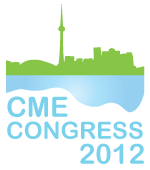Leila Lax (University of Toronto Mississauga); Marlene Scardamalia (IKIT, OISE/University of Toronto); Anita Singh (Temmy Latner Centre for Palliative Care, Mount Sinai Hospital)
Synopsis
Social network structural and semantic analyses enables us to consider how new cultural tools, such as Knowledge Forum, supports sociocognitive interactions and participant structures that have the potential to change asymmetries and shift traditional pedagogic paradigms toward collaboration, network distribution, and democratization in CME. Contrary to popular notions of democratization in education, the expert/teacher/facilitator may be extremely active as a “partner” and co-creator of knowledge within a social network and the online discourse, while sharing the core power position.
Purpose
Social network structural and semantic analyses enables us to consider how new cultural tools, such as Knowledge Forum, supports sociocognitive interactions and participant structures that have the potential to change asymmetries and shift traditional pedagogic paradigms toward collaboration, network distribution, and democratization in CME.
Knowledge Building is a fundamentally social process requiring creation and continual improvement of ideas, with members sharing responsibility for advancing not just individual, but group knowledge. The assessment of online collective knowledge improvement, beyond pre/post-tests outcomes, has been somewhat challenging. Online activity in most Web-based CME courses is measured in terms of individual read/write activity statistics. Social network analysis provides us with collective measures and tools to answer questions about how knowledge improves – by examining relationships between individuals and within a community; not just individual accomplishment.
Methods
This research study examined collaborative Knowledge Building in the End-of-Life Care Distance Education Program using social network structural and semantic analyses.
Results
Shifts in facilitator/student centrality relationships demonstrated strength of student network interactions. Power analysis demonstrated shared core position between facilitator and students. Most remarkable were the number of cliques the facilitator belonged to. Contrary to popular notions of democratization in education, the expert/teacher/facilitator may be extremely active as a “partner” and co-creator of knowledge within a social network and online discourse in CME. “Partner” is distinguished from “mentor”.
Conclusions
Social network structural and semantic relationships herein are indicative of Knowledge Building principles of symmetry, community knowledge/collective responsibility, and epistemic agency, necessary for the democratization of CME.
Declaration
No real or apparent conflict(s) of interest.





